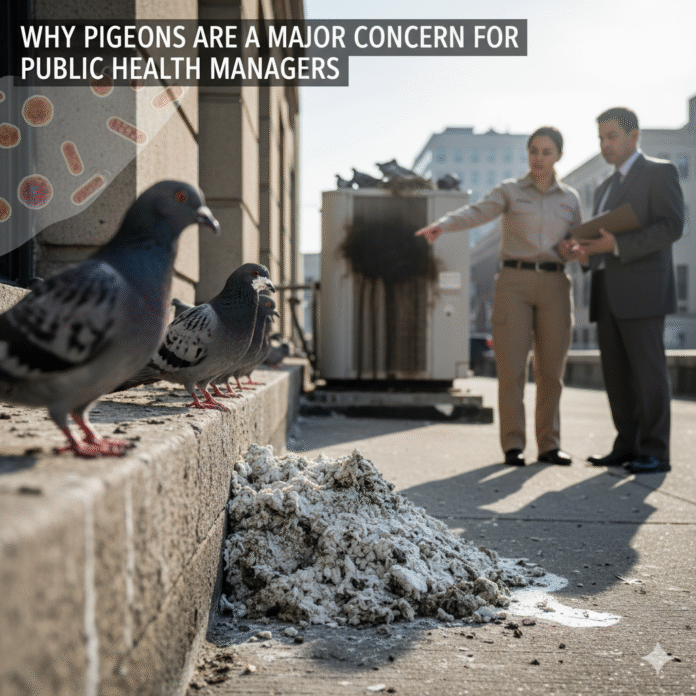Have you ever stopped to truly observe the pigeons cooing and strutting in your local park or city square? To many, they’re just another part of the urban landscape, often ignored or even considered a nuisance. However, for public health managers, these common birds represent a significant and complex challenge. Far from being harmless feathered friends, pigeons can play a crucial role in the transmission of diseases, contribute to allergenic reactions, and even cause structural damage that impacts public safety. Understanding their impact is not just about managing a pest; it’s about safeguarding community well-being and maintaining healthy urban environments. This post will delve into why pigeons demand serious attention from those tasked with protecting our health.
The Hidden Health Risks Pigeons Pose
Pigeons, though small, can be vectors for a surprising array of pathogens. Their droppings, nesting materials, and even their presence can contribute to various health issues in humans.
Zoonotic Diseases: When Bird Meets Human
One of the most pressing concerns is the transmission of zoonotic diseases. These are illnesses that can pass from animals to humans, and pigeons are known carriers of several. Read the full article based on the World Health Organization (WHO) report highlighting well-known facts about zoonoses.
- Histoplasmosis: This respiratory disease is caused by a fungus found in pigeon droppings, especially when they accumulate and become airborne. Symptoms can range from mild flu-like illness to serious lung infections.
- Cryptococcosis: Another fungal disease, Cryptococcus neoformans, is commonly found in pigeon droppings. It primarily affects individuals with weakened immune systems, potentially causing meningitis or lung infections.
- Psittacosis (Ornithosis): Often called “parrot fever,” this bacterial infection can be transmitted from pigeons to humans through inhaling dried droppings or respiratory secretions. Symptoms include fever, chills, and pneumonia.
- Salmonellosis: While commonly associated with food, Salmonella bacteria can also be present in pigeon droppings and transmitted through contaminated surfaces or food.
Allergens and Respiratory Irritants
Beyond direct disease transmission, pigeons contribute to poor air quality and can trigger allergic reactions.Want to know how polluted air impacts both body and mind? Check out our post, Delhi’s Toxic Air Isn’t Just Hurting Your Lungs — It’s Impacting Your Mental Health Too.
- Feather Dust and Dander: Pigeons constantly shed feathers and dander, which can become airborne. This can exacerbate conditions like asthma and cause allergic rhinitis in sensitive individuals.
- Dropping Particulates: Dried pigeon droppings break down into fine dust particles. Inhaling these particles can lead to respiratory irritation and, in some cases, more severe lung problems.
Structural Damage and Its Public Health Implications
It’s not just direct health issues; the physical presence of pigeons can lead to significant infrastructure problems that indirectly affect public health and safety.
Corrosion and Contamination of Buildings
Pigeon droppings are highly acidic and can cause considerable damage to buildings and public spaces.
- Degradation of Materials: Over time, droppings can corrode metal, stone, and other building materials, leading to costly repairs and compromising structural integrity.
- Contamination of HVAC Systems: Pigeons often nest near or in air conditioning units and vents. Their droppings and nesting materials can be drawn into HVAC systems, contaminating the air circulated indoors and spreading pathogens.
Slips, Falls, and Aesthetic Concerns
Accumulated droppings create a hazardous environment.
- Slippery Surfaces: Wet pigeon droppings make sidewalks, ledges, and public walkways incredibly slippery, leading to an increased risk of slips and falls. This poses a significant liability for public health and city management.
- Unsanitary Appearances: Large amounts of droppings create an unsightly and unsanitary environment, impacting public perception of cleanliness and potentially deterring people from using public spaces.
The Role of Public Health Managers in Pigeon Control
Given these multifaceted risks, public health managers play a critical role in developing and implementing effective pigeon management strategies.
H3: Integrated Pest Management (IPM) Approaches
A successful strategy involves a combination of methods, not just eradication.
- Exclusion: Modifying structures to prevent pigeons from landing or nesting. This includes using netting, spikes, and wires.
- Habitat Modification: Reducing access to food and water sources. This involves better waste management and encouraging the public not to feed pigeons.
- Repellents: Utilizing visual, auditory, or olfactory repellents, though their effectiveness can vary.
- Cleaning and Sanitation: Regular and thorough cleaning of affected areas to remove droppings and nesting materials, reducing pathogen exposure.
H3: Public Education and Awareness
Engaging the community is vital for long-term success.
- Discouraging Feeding: Educating the public about the negative consequences of feeding pigeons, as this encourages larger populations.
- Reporting Infestations: Encouraging citizens to report significant pigeon activity or droppings in public areas to relevant authorities.
- Hygiene Practices: Advising individuals, especially those working in areas with high pigeon activity, to practice good hand hygiene.
Challenges and Future Directions
Managing pigeon populations is not without its difficulties, and evolving urban environments present new challenges.
Ethical Considerations and Public Perception
- Humane Methods: Public health managers must balance effectiveness with humane treatment of animals, often facing public scrutiny over control methods.
- Community Buy-in: Gaining public support for control measures is crucial, as misinformed opinions can hinder efforts.
Surveillance and Research
- Monitoring Disease Trends: Continuous surveillance for pigeon-borne diseases is essential to detect outbreaks early.
- Innovative Solutions: Exploring new technologies and research into more effective and sustainable pigeon control methods.
Conclusion: A Call for Proactive Management
In conclusion, pigeons are far more than just “sky rats” or benign urban dwellers. Their ability to transmit diseases, contribute to allergies, and cause structural damage makes them a significant public health concern. For public health managers, understanding these risks and implementing proactive, integrated management strategies is paramount. By focusing on exclusion, habitat modification, public education, and ongoing surveillance, we can mitigate the health hazards posed by these ubiquitous birds, ensuring safer and healthier urban environments for everyone. The well-being of our communities truly depends on effective pigeon management.





